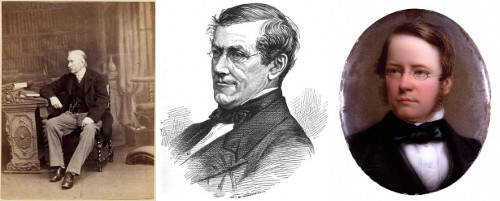
The Wheatstone bridge circuit was invented by Samuel Hunter Christie but named after Charles Wheatstone, who developed the Playfair cipher … which was named after Lyon Playfair.
See Who’s On First?

The Wheatstone bridge circuit was invented by Samuel Hunter Christie but named after Charles Wheatstone, who developed the Playfair cipher … which was named after Lyon Playfair.
See Who’s On First?
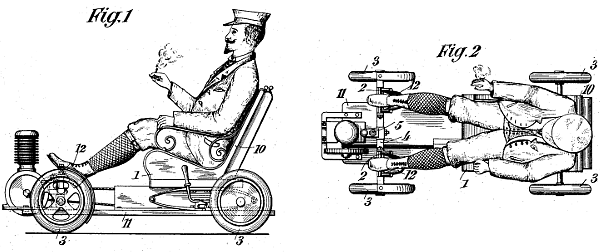
Parking was already a problem in 1906, so Swiss inventor Martin Fischer offered a car that you can drive right up to your apartment:
The width of the frame is smaller than the distance of the wheels. That distance amounts to at most seventy-five centimeters. Consequently the motor-car can pass through doors of ordinary width and up staircases with such ease that even persons residing on the upper floors of ordinary dwelling-houses will be able to keep such motor-cars without the necessity of providing special storage space on the ground floor.
It’s built low to reduce the risk of tipping over when traveling around sharp curves. But what happens if you meet someone else on the stairs?
New Zealand engineer Bill Phillips found a unique way to model a national economy in 1949: He used water. Working in his garage, he assembled a conglomeration of tanks, pipes, sluices, and valves into MONIAC, a 7-foot hydraulic computer that modeled the economy of the United Kingdom. Colored water, representing money, is pumped from a bottom reservoir to the top, where it’s distributed among taxes, consumer expenditure, and investment, then finds its way downward through the economy. The user can set “functions” that regulate the effect of national income on tax revenue, government spending on consumption, domestic spending on imports or exports, the interest rate on investment, and the exchange rate on exports and imports.
“To approximate a national economy, a ‘Federal Reserve System’ is added (from a tank through the top U-shaped pump) and bank credit is drawn to expand surplus balances when needed,” noted Fortune in a March 1952 feature. “And, if a Keynesian touch is wanted, the government can engage in ‘deficit financing’ by tapping the surplus balances to increase its own expenditures without additional taxation.”
Phillips unveiled the computer at the London School of Economics in 1949 and impressed his audience so much that he was asked to build copies for Harvard, Cambridge, Oxford, the Ford Motor Company and the Central Bank of Guatemala. Unfortunately his invention was soon outmoded by electronic computers, and today only two working “Phillips machines” remain: one at Cambridge and the other (above) at the Reserve Bank of New Zealand.
UPDATE: Yale economist Irving Fisher proposed a similar system in his Ph.D. dissertation in 1891, described by Paul Samuelson as “the best of all doctoral dissertations in economics.” Fisher used a working model of his machine as a teaching tool for 25 years. (Thanks, Sroyon.)
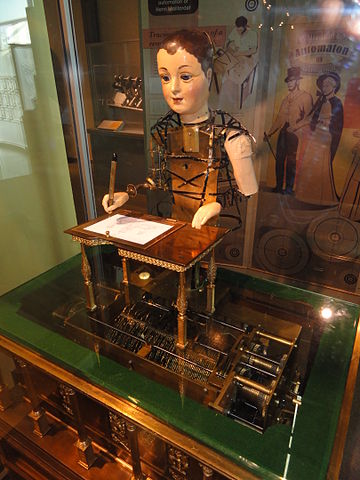
Martin Scorsese’s film Hugo was inspired by a real event. In 1928 Philadelphia’s Franklin Institute received the remains of an 18th-century brass automaton that had been damaged in a fire. It had been donated by the descendants of wealthy manufacturer John Penn Brock; they knew it had been acquired in France and supposed it to be the work of the German inventor Johann Nepomuk Maelzel, famed for his metronome.
The institute’s machinist set about restoring the machine and discovered that its mechanism used an ingenious system of cams to store almost 300 kilobits of information. When he had finished his work, he placed a pen in its hand and watched it draw four strikingly elaborate illustrations and write three poems (click to enlarge):
The final poem contained a surprise — in its border the machine wrote Ecrit par L’Automate de Maillardet, “written by the automaton of Maillardet.” The automaton’s creator was not Johann Maelzel but the Swiss mechanician Henri Maillardet — and this fact had been remembered only because he had taught the machine to write his name.
Subsequent research showed that Maillardet had created the automaton in the 1700s and exhibited it throughout Europe and Russia. How it came to America is not known. It’s on display today at the Franklin Institute, which demonstrates its talents publicly several times a year.
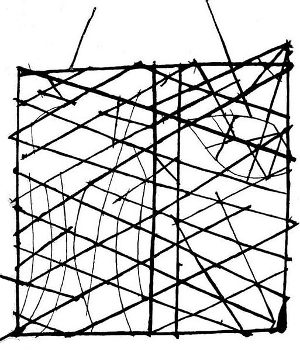
What is this? It’s a map. In order to navigate by canoe among the Marshall Islands, residents made charts by lashing together sticks, threads, and shells to represent landmasses and the patterns of ocean swells and breakers between them.
The atolls lie so low that even the tops of the palms are lost to sight 20 kilometers off shore, so a Marshallese navigator may spend several days out of sight of land. Having studied swell patterns with the aid of such charts, he can find his way by observing the motion of his canoe.
For example, an island breaks up the easterly trade wind swell, producing a wave pattern that signals the presence of land. “These navigation signs … extend seaward from any atoll or island in specific quadrants and can be detected up to 40 km away,” writes oceanographer Joseph Genz. “The relative strength of these radiating wave patterns indicates the distance toward land, while the specific wave signatures indicate the direction of land.”
(Joseph Genz et al., “Wave Navigation in the Marshall Islands,” Oceanography, June 2009.)
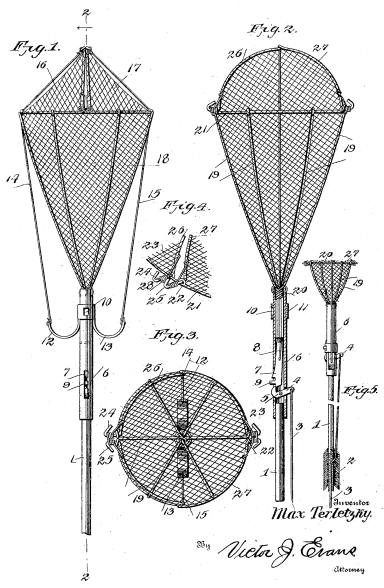
Frustrated in catching insects in 1904, Max Terletzky hit on this rather alarming solution. A basket with an open mouth is attached to the business end of a feathered arrow; the prospective bug hunter props open the basket’s mouth, stalks his prey, and fires at it using a bow. The arrow is attached to a cord in the archer’s hand, which closes the basket doors when the arrow has intercepted the bug and reached the limit of its flight. At that point the arrow drops to the ground and the archer can draw in the cord and claim his prize.
Terletzky writes, “This particular construction of the automatic device for closing the doors of the basket is extremely strong, simple, and durable in construction, as well as thoroughly efficient in operation.” For all I know he’s right.

In Saint Petersburg, an equestrian statue of Peter the Great stands atop an enormous pedestal of granite. The statue was conceived by French sculptor Étienne Maurice Falconet, who envisioned the horse rearing at the edge of a great cliff under Peter’s restraining hand.
Casting the horse and rider was relatively easy; harder was finding a portable cliff. In September 1768 a peasant led authorities to an enormous boulder half-buried near the village of Konnaia, four miles north of the Gulf of Finland and about 13 miles from the center of Saint Petersburg. Falconet proposed cutting it into pieces, but Catherine the Great, who wanted to show off Russia’s technological potential, ordered it moved whole, “first by land and then by water.”
Incredibly, she got her wish. The unearthed boulder measured 42 feet long, 27 feet wide, and 21 feet high; even when trimmed by a third it weighed an estimated 3 million pounds. But it was mounted on a chassis and rolled along atop large copper ball bearings, a “mountain on eggs,” as stonecutters worked continuously to shape it. When they reached the Gulf of Finland it was transferred precariously to a barge mounted between two cutters of the imperial navy, which carried it carefully to the pier at Senate Square, where it was installed in 1770, after two years of work. The finished pedestal stands 21 feet tall.
“The daring of this enterprise has no parallel among the Egyptians and the Romans,” marveled the Journal Encyclopédique; the English traveler John Carr said that the feat astonished “every beholder with a stupendous evidence of toil and enterprise, unparalleled since the subversion of the Roman empire.” It remains the largest stone ever moved by man.

When Jos de Vink retired from a career in computer technology in 2002, he began casting about for an engaging project. His neighbor, a passionate model builder, challenged him to design a working hot air engine driven solely by the heat of a tea or wax light.
De Vink produced a trial engine using the principles of the first hot air engine built by Robert Stirling in 1816. He displayed it for his model club and at a model exhibition in the Netherlands and, encouraged by the response, began to build more.
By 2010 he had created about 27 engines and began construction on several Stirling low temperature difference (LTD) engines that can run on the warmth of a human hand.
“De Vink designs his engines from scraps of brass and bronze from a scrap dealer,” writes Art Donovan in The Art of Steampunk. “The machines demonstrate the possibility of moving large objects using little energy and show different drive techniques used by hot air engine builders for the past two centuries.”

Hitler’s chief architect, Albert Speer, favored a “theory of ruin value” in which German buildings would collapse into aesthetically pleasing ruins, like those of classical antiquity. “I want German buildings to be viewed in a thousand years as we view Greece and Rome,” he said.
Using special materials and applying statistical principles, Speer claimed to have created structures that in 1,000 years would resemble Roman ruins. “The ages-old stone buildings of the Egyptians and the Romans still stand today as powerful architectural proofs of the past of great nations, buildings which are often ruins only because man’s lust for destruction has made them such,” he wrote.
Hitler liked to say that the purpose of his building was to transmit his time and its spirit to posterity. Ultimately, all that remained to remind men of the great epochs of history was their monumental architecture, he remarked. What then remained of the emperors of the Roman Empire? What would still give evidence of them today, if not their buildings […] So, today the buildings of the Roman Empire could enable Mussolini to refer to the heroic spirit of Rome when he wanted to inspire his people with the idea of a modern imperium. Our buildings must also speak to the conscience of future generations of Germans.
Hitler endorsed the idea, favoring the use of durable materials such as granite to reflect his soaring ambitions. “As capital of the world,” he said, “Berlin will be comparable only to ancient Egypt, Babylon, or Rome!” Ironically, this came true: When ancient Rome collapsed, its greatest buildings were pillaged for building materials, and when the Russians demolished Speer’s grandiose Chancellery in 1947, its marble was reused to build a metro station.
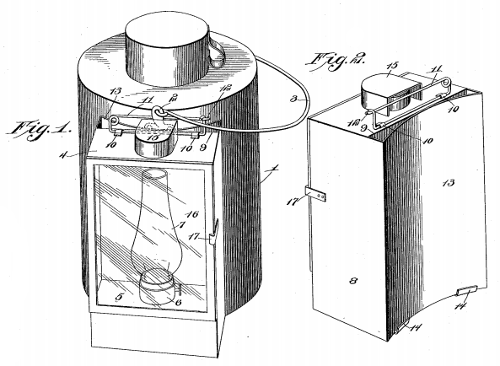
Christina Malmo of Montana patented this combination lantern and dinner pail in 1905. The lantern, which contains its own fuel source, hugs the pail, “conducting heat to the victuals within.”
“This close connection between the lamp attachment and the dinner-pail serves the double purpose of steadying the lamp, thus avoiding any swinging which would occur were the lamp attached by any loose means. The second utility of this close connection is that the heat from the lamp is thus utilized in warming the victuals within the dinner-pail, a very useful advantage to a miner or any one who is obliged to carry his dinner for any length of time.”